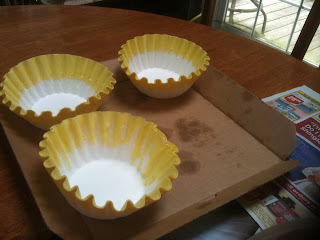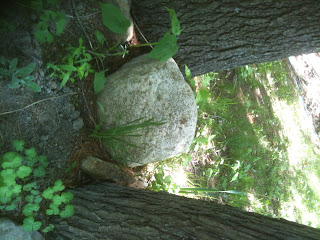May 22 & 23, 2012 Day 164 and 165
Math: 2 pages
Latin: Chapter 2 of new book &
vocab cards
LA Book: 2 pages * Finished Book!
Geology of the Eastern Coast 6 x 6 TWO
Pages 20-24 and 31, 34-top of 36
6 Vocabulary 1. Acidic: from acids, which are chemical compounds that taste sour. Examples are vinegar and lemon juice
2. Carbon dioxide: a gas formed by the rotting of plants and animals and when animals breathe out
3. Old growth forest: a forest that is very old
4. Coal: A dark brown or black rock formed from decayed plants, coal is used as a fuel
5. Oil: a thick dark liquid that occurs naturally beneath the Earth. Oil can be separated into many products including gasoline, and other fuels.
6. New Madrid Seismic Zone: A system of faults right in the middle of the North American plate
6 Sentences 1. Chemical processes break down rocks; an example is when acidic water flows over them.
2. All rainfall is naturally acidic but just slightly, I’s because of the mixture of carbon dioxide in the air and the water creating an acidic chemical.
3. About one quarter of the Great Smoky Mountains is old-growth forests.
4. Coal is a black rock that is mostly made of carbon.
5. There are abundant resources such as coal and oil.
Pages 20-24 and 31, 34-top of 36
6 Vocabulary 1. Acidic: from acids, which are chemical compounds that taste sour. Examples are vinegar and lemon juice
2. Carbon dioxide: a gas formed by the rotting of plants and animals and when animals breathe out
3. Old growth forest: a forest that is very old
4. Coal: A dark brown or black rock formed from decayed plants, coal is used as a fuel
5. Oil: a thick dark liquid that occurs naturally beneath the Earth. Oil can be separated into many products including gasoline, and other fuels.
6. New Madrid Seismic Zone: A system of faults right in the middle of the North American plate
6 Sentences 1. Chemical processes break down rocks; an example is when acidic water flows over them.
2. All rainfall is naturally acidic but just slightly, I’s because of the mixture of carbon dioxide in the air and the water creating an acidic chemical.
3. About one quarter of the Great Smoky Mountains is old-growth forests.
4. Coal is a black rock that is mostly made of carbon.
5. There are abundant resources such as coal and oil.
6. The area of the New Madrid seismic zone is
in the area where Missouri, Kentucky, Arkansas, and Tennessee meet.
6 Facts/ Details
1. The Appalachian Mountain trail runs from Mt. Kahtadin Maine to Springer Mountain Georgia, It goes through 14 states!
2. In the Great Smoky Mountains there are over 17,000 species of organisms, over 100 species of trees, 1,6000 species of flowering plants, 66 species of mammals, about 1,500 black bears live in the park!, 200 species of bird and 50 species of fish, and at least 30 species of salamanders
3. Last March, the Japan Earthquake ranked the fourth largest earthquake since 1900!
4. In August of 2011, there was an Earthquake in Virginia that nearly collapsed the Washington monument.
5. The Japan Earthquake measured 9.0 on the Richter scale that is a HUGE EARTHQUAKE!
6. The Appalachian mountains used to be the barrier for people traveling west such as Daniel Boone.
6 Questions 1. What are some of the smaller mountain ranges that make up the Appalachians? A: the Blue Ridge mountains, The great Smoky mountains, and the Cumberland mountains
2. What states do the Appalachians travel through? A: 14 states: Maine, New Hampshire, Vermont, Massachusetts, Connecticut, New York, New Jersey, Pennsylvania, Maryland, Virginia, West Virginia, Tennessee, North Carolina, and Georgia.
3. What are the three major types of rocks you can find in the Appalachians *and describe them? A: Metamorphic rock, originally sedimentary or igneous, Volcanic rock, rocks formed from cooled lava, and Sedimentary rock, formed from the ocean
4. What are the ingredients needed for erosion to occur? A: A rock can rub against another rock which could be a recipe for erosion, or a rock could break down by wind, water, and ice, or by a rock being pushed against a strong tree can cause erosion
5. Describe the two big earthquakes in the New Madrid Seismic Zone: In 1811 and 1812 there were two huge earthquakes that happened in the New Madrid seismic zone
6. What happened in Virginia on Aug. 23, 2011? A: there was an earthquake that almost collapsed the Washington monument.
6 things you think are cool about rocks and geology 1. I like learning about how mountains, volcanoes, rocks, and the Earth were formed.
2. I like this Geology fact: That the tectonic plates under the surface of the Earth create our “landmarks” and “landscape.”
3. I think it’s cool that scientists believe we are going to become Pangea Ultima in about 1 million years.
4. I like that Geology studies everything about the Earth and not just how it was formed but how everything was formed.
5. I like learning about earthquakes and shockwaves.
6. I think it’s cool how underwater earthquakes trigger Tsunamis.
6 Facts/ Details
1. The Appalachian Mountain trail runs from Mt. Kahtadin Maine to Springer Mountain Georgia, It goes through 14 states!
2. In the Great Smoky Mountains there are over 17,000 species of organisms, over 100 species of trees, 1,6000 species of flowering plants, 66 species of mammals, about 1,500 black bears live in the park!, 200 species of bird and 50 species of fish, and at least 30 species of salamanders
3. Last March, the Japan Earthquake ranked the fourth largest earthquake since 1900!
4. In August of 2011, there was an Earthquake in Virginia that nearly collapsed the Washington monument.
5. The Japan Earthquake measured 9.0 on the Richter scale that is a HUGE EARTHQUAKE!
6. The Appalachian mountains used to be the barrier for people traveling west such as Daniel Boone.
6 Questions 1. What are some of the smaller mountain ranges that make up the Appalachians? A: the Blue Ridge mountains, The great Smoky mountains, and the Cumberland mountains
2. What states do the Appalachians travel through? A: 14 states: Maine, New Hampshire, Vermont, Massachusetts, Connecticut, New York, New Jersey, Pennsylvania, Maryland, Virginia, West Virginia, Tennessee, North Carolina, and Georgia.
3. What are the three major types of rocks you can find in the Appalachians *and describe them? A: Metamorphic rock, originally sedimentary or igneous, Volcanic rock, rocks formed from cooled lava, and Sedimentary rock, formed from the ocean
4. What are the ingredients needed for erosion to occur? A: A rock can rub against another rock which could be a recipe for erosion, or a rock could break down by wind, water, and ice, or by a rock being pushed against a strong tree can cause erosion
5. Describe the two big earthquakes in the New Madrid Seismic Zone: In 1811 and 1812 there were two huge earthquakes that happened in the New Madrid seismic zone
6. What happened in Virginia on Aug. 23, 2011? A: there was an earthquake that almost collapsed the Washington monument.
6 things you think are cool about rocks and geology 1. I like learning about how mountains, volcanoes, rocks, and the Earth were formed.
2. I like this Geology fact: That the tectonic plates under the surface of the Earth create our “landmarks” and “landscape.”
3. I think it’s cool that scientists believe we are going to become Pangea Ultima in about 1 million years.
4. I like that Geology studies everything about the Earth and not just how it was formed but how everything was formed.
5. I like learning about earthquakes and shockwaves.
6. I think it’s cool how underwater earthquakes trigger Tsunamis.
6 Cool Rock pictures from garden/pond or walk
Civil War Trip
Project: Plan, Prep, Start, & Finish Scrapbook
Sophie’s Blog: I
made my scrapbook out of an old binder and binder sheets. We collected
brochures and maps on our trip and took lots of pictures. I started my
scrapbook with the first day of our trip, at the visitor’s center. I have
pictures from the museum and cyclorama. Then I moved on to the second day of
our trip, the first day of the battle on cemetery hill. Lily and I love cannons
so we took lots of pictures with them, they needed their own page! On the
second day we had a guide named Jim that took us around through the battle
field and he was really nice. I have a page talking about him. Then I have 7
pages from my 6 x 6’s about our Gettysburg. Then pictures of us on little round
top when Jim told us a story about Joshua Chamberlain and Little Round top.
Then I have my Fredericksburg map and 6 x 6 on Fredericksburg. I have two pages
about Fredericksburg and then one page with brochures of Civil War battle sites
that we drove by but didn’t stop at.
Gifts: Made some
birthday & “miss you” gifts thanks to my new found obsession/inspiration:
Pintrest
These are melted "pony" or plastic bead suncatchers--arrange beads on cookie sheet using tin tops, free-form shapes with foil, or cookie cutters. Oven set at 400 degrees--these smell so open a window and use a fan to ventilate!
Ours took about 20 mins to melt all the way but start checking at 10 mins.
Very cool, fun, cheap project!
Next we did a coffee filter Spring wreathe for Emma's birthday!
























































